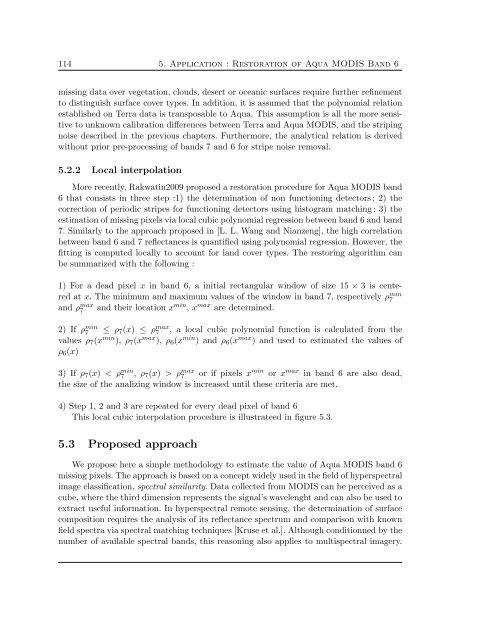Th`ese Marouan BOUALI - Sites personnels de TELECOM ParisTech
Th`ese Marouan BOUALI - Sites personnels de TELECOM ParisTech
Th`ese Marouan BOUALI - Sites personnels de TELECOM ParisTech
You also want an ePaper? Increase the reach of your titles
YUMPU automatically turns print PDFs into web optimized ePapers that Google loves.
114 5. Application : Restoration of Aqua MODIS Band 6<br />
missing data over vegetation, clouds, <strong>de</strong>sert or oceanic surfaces require further refinement<br />
to distinguish surface cover types. In addition, it is assumed that the polynomial relation<br />
established on Terra data is transposable to Aqua. This assumption is all the more sensitive<br />
to unknown calibration differences between Terra and Aqua MODIS, and the striping<br />
noise <strong>de</strong>scribed in the previous chapters. Furthermore, the analytical relation is <strong>de</strong>rived<br />
without prior pre-processing of bands 7 and 6 for stripe noise removal.<br />
5.2.2 Local interpolation<br />
More recently, Rakwatin2009 proposed a restoration procedure for Aqua MODIS band<br />
6 that consists in three step :1) the <strong>de</strong>termination of non functioning <strong>de</strong>tectors ; 2) the<br />
correction of periodic stripes for functioning <strong>de</strong>tectors using histogram matching ; 3) the<br />
estimation of missing pixels via local cubic polynomial regression between band 6 and band<br />
7. Similarly to the approach proposed in [L. L. Wang and Nianzeng], the high correlation<br />
between band 6 and 7 reflectances is quantified using polynomial regression. However, the<br />
fitting is computed locally to account for land cover types. The restoring algorithm can<br />
be summarized with the following :<br />
1) For a <strong>de</strong>ad pixel x in band 6, a initial rectangular window of size 15 × 3 is centered<br />
at x. The minimum and maximum values of the window in band 7, respectively ρ min<br />
7<br />
and ρ max<br />
7 and their location x min , x max are <strong>de</strong>termined.<br />
2) If ρ min<br />
7 ≤ ρ 7 (x) ≤ ρ max<br />
7 , a local cubic polynomial function is calculated from the<br />
values ρ 7 (x min ), ρ 7 (x max ), ρ 6 (x min ) and ρ 6 (x max ) and used to estimated the values of<br />
ρ 6 (x)<br />
3) If ρ 7 (x) < ρ min<br />
7 , ρ 7 (x) > ρ max<br />
7 or if pixels x min or x max in band 6 are also <strong>de</strong>ad,<br />
the size of the analizing window is increased until these criteria are met.<br />
4) Step 1, 2 and 3 are repeated for every <strong>de</strong>ad pixel of band 6<br />
This local cubic interpolation procedure is illustrateed in figure 5.3.<br />
5.3 Proposed approach<br />
We propose here a simple methodology to estimate the value of Aqua MODIS band 6<br />
missing pixels. The approach is based on a concept wi<strong>de</strong>ly used in the field of hyperspectral<br />
image classification, spectral similarity. Data collected from MODIS can be perceived as a<br />
cube, where the third dimension represents the signal’s wavelenght and can also be used to<br />
extract useful information. In hyperspectral remote sensing, the <strong>de</strong>termination of surface<br />
composition requires the analysis of its reflectance spectrum and comparison with known<br />
field spectra via spectral matching techniques [Kruse et al.]. Although conditionned by the<br />
number of available spectral bands, this reasoning also applies to multispectral imagery.















